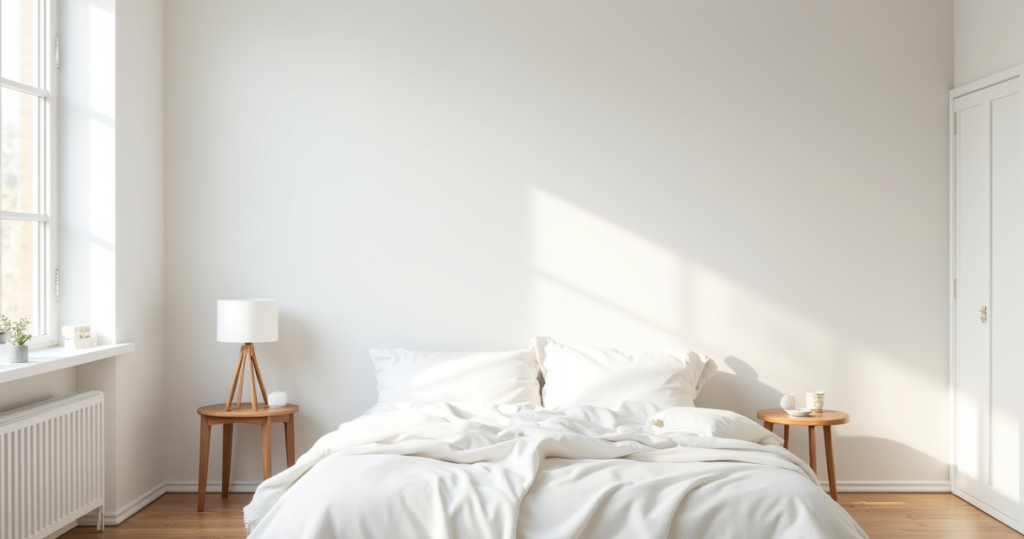You know the question people always ask me? “Jasmine, your entire world is about jewel tones and vibrant patterns from India… so why are we talking about a white bedroom?” And I get it! It feels like a contradiction. But here’s a secret I learned a long time ago: white isn’t the absence of color. It’s the stage for everything else. It’s the quiet dawn before the market opens, the pristine marble of the Taj Mahal that catches the golden light and tells a million stories in its glow.
A white bedroom isn’t about sterility; it’s about sanctuary. But getting it right is an art. Slap white paint on four walls and you’ll have a hospital room. The real magic—the stuff that makes you feel held and peaceful—is in the layers. It’s in the textures that whisper stories, the organic forms that ground you, and the personal touches that give the space its heartbeat. So forget the soulless, minimalist box. Let’s create a sanctuary that breathes.
Laying the Pure White Foundation: Essential Planning
This is where everyone rushes and gets it wrong. They grab a can of “Pure White” and start rolling. No, no, no! Creating a room with soul starts with intention. Think of this as preparing the canvas—choosing the perfect gesso, understanding how the light will fall, and clearing the space so the art can actually shine. This is the quiet work that makes all the loud, beautiful stuff possible.
1. Select the Perfect White Shade to Evoke Desired Mood
The biggest misconception is that “white” is a single color. It’s a whole family of colors, and each one has a soul. You have whites that whisper with hints of rose, whites that feel like creamy cafe au lait, and whites with the cool, crispness of a mountain morning. Choosing the right one is about listening to your room. A north-facing room that gets cool, blue light all day will feel like a freezer if you paint it a stark, blue-toned white. It needs a white with a creamy, sun-kissed soul to feel warm.

I once had a client who insisted on a brilliant, gallery-white for her north-facing bedroom. She wanted “clean.” What she got was “clinical.” No matter how many warm blankets we added, it felt cold. We repainted with a white that had the softest, blush-pink undertone—barely perceptible, like the inside of a seashell. Suddenly, the room was a hug. That’s the difference. The shortcut? Never, ever pick a white from a tiny chip under fluorescent store lights. Paint large sample boards and move them around the room for at least 48 hours. Watch how the color changes as the sun moves. Let the room tell you which white it wants to wear.
A single layer of paint isn’t enough; your foundation needs a soul. Let’s talk about how the light itself becomes your most important collaborator.
2. Understand Natural Light’s Transformative Effect on White Walls
Light is the dance partner to your white walls. In India, architects have obsessed over light for centuries, carving intricate marble screens, or jaali, not just to block the sun but to make the light dance into the room, creating patterns and life. Your white bedroom is no different. The same creamy white that looks soft and dreamy in the morning sun might look a bit dingy in the flat light of late afternoon. You have to understand how the light enters your space throughout the day.
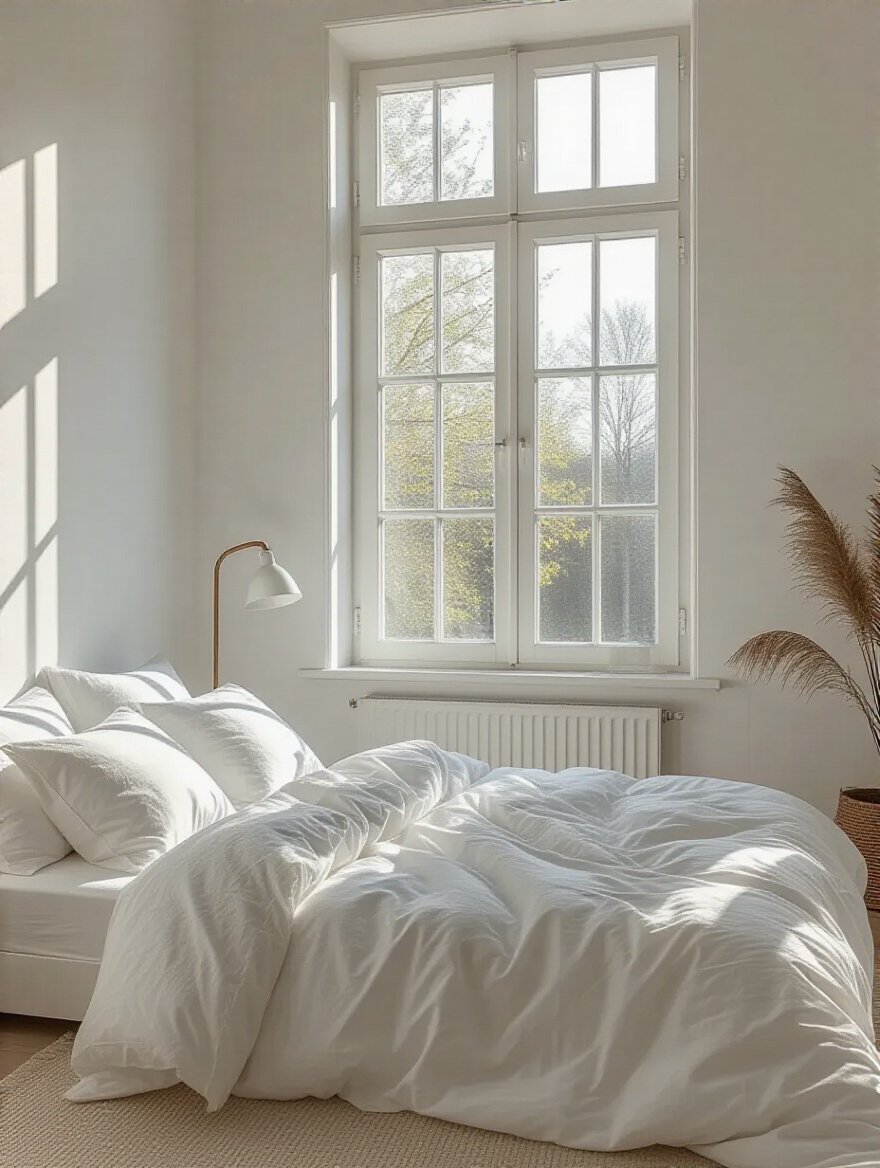
The biggest mistake is thinking about light as just a utility. It’s an ingredient. Does a big, south-facing window flood the room with golden light all day? You can afford to use a cooler, crisper white because the light itself will warm it up. Is your only window facing a brick wall? You’ll need a white with a high Light Reflectance Value (LRV) and a warm heart to keep it from feeling like a cave. Stand in the room at different times. See where the light lands. That interaction is where the real design happens, and it’s what will make your room feel expansive and serene instead of just… white.
Once you’ve honored the light, it’s time to decide what will live in it. And that means being beautifully ruthless.
3. Embrace Purposeful Minimalism for a Calm, Uncluttered Retreat
Can we talk about how everyone gets minimalism wrong? It’s not about owning nothing. It’s about making sure everything you own has a purpose or a story. A cluttered space is a cluttered mind, and a white room highlights every single piece of clutter like it’s under a spotlight. Your goal isn’t austerity; it’s serenity. It’s the difference between an empty room and a peaceful one. The first feels lonely, the second feels restorative.
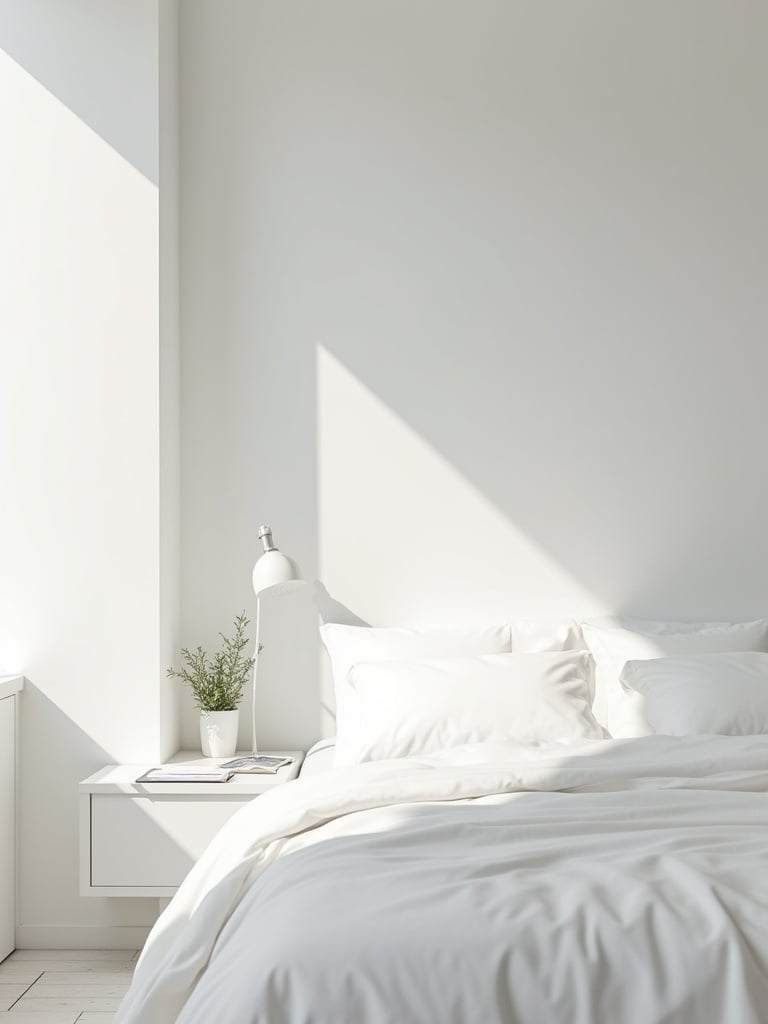
Think of it like a temple. A temple isn’t empty, but every object—the bell, the incense holder, the deity—has a profound reason for being there. Ask yourself: does this object serve me? Does it bring me joy? Or is it just visual noise? This is your sanctuary for sleep and rest. The pile of unsorted mail doesn’t belong here. The exercise bike you use as a coat rack? It’s stressing you out. The real work is ruthless editing, followed by brilliant, hidden storage. A beautiful chest at the foot of the bed, a sleek built-in wardrobe—these are your best friends. Keep your surfaces clear, and you’ll clear your mind.
With a clean slate, you’re ready to start weaving your story. This is where the mood board comes in, and it’s your most powerful tool.
4. Create a Cohesive Vision with a Curated White Decor Mood Board
A mood board isn’t just for designers; it’s your visual promise to yourself. For a white room, it is absolutely non-negotiable. Why? Because when you’re only working with one primary color, texture and tone are everything. A digital board is fine, but I beg you, make a physical one. You need to see how a creamy white linen swatch looks next to a crisp white cotton. You need to feel the nubby texture of a wool sample next to a smooth piece of light oak.

This is where you catch mistakes before they become expensive regrets. That stark white dresser you saw online? You’ll realize on your mood board that it clashes horribly with your warm, creamy walls. Your mood board is your story in miniature. It should have your main wall color, your trim color, a fabric swatch from your bedding, a sample of your flooring, a picture of your key furniture, and a sliver of the metallics you want to use. This is your bible. It’s what keeps you from getting distracted and buying a rogue pillow that doesn’t fit the narrative. It’s the difference between a collection of white things and a cohesive, soul-stirring space.
Building Your All-White Haven: Key Furniture & Surfaces
Now for the big pieces—the bones of the room. This isn’t about filling space; it’s about choosing anchors that feel light, airy, and full of grace. These are the elements that will either support your serene vision or fight against it. Think soft, think natural, and think textural.
5. Choose Foundational Furniture Pieces in White or Natural Tones
Your bed, your dressers, your nightstands—these are the anchors of your room. In a white sanctuary, you want them to feel grounded but not heavy. White or light, natural wood pieces are your secret weapon. They blend into the walls, creating an unbroken sense of space that instantly makes the room feel bigger and calmer. Think bleached oak, pale mango wood, or even beautiful cane or rattan furniture that feels light and lets the air pass through.

I had a client with a small, dark bedroom who dreamed of a massive, dark-wood heirloom bed. It was beautiful, but it consumed the room. We switched it for a simple, low-profile bed frame in a light ash wood and suddenly, the room could breathe. The goal is to create a seamless, calming envelope. You can add drama later with other elements, but your foundational pieces should be the quiet, supportive chorus, not the screaming lead singer. Look for clean lines and natural finishes. They provide the perfect, serene backdrop for the layers of texture we’re about to add.
With the furniture softly in place, it’s time to turn our attention to the largest surface of all: the walls themselves.
6. Maximize Light with Bright, Expansive White Wall Finishes
We’ve chosen our perfect white, but how we apply it matters just as much. You want a finish that diffuses light softly, not one that bounces it around like a disco ball. For walls, a flat or matte finish is your best friend. It has a velvety, chalky quality that absorbs light and creates a sense of infinite depth. It feels soft and serene, and it hides imperfections beautifully. A high-gloss white wall, on the other hand, can feel harsh and create a glare.
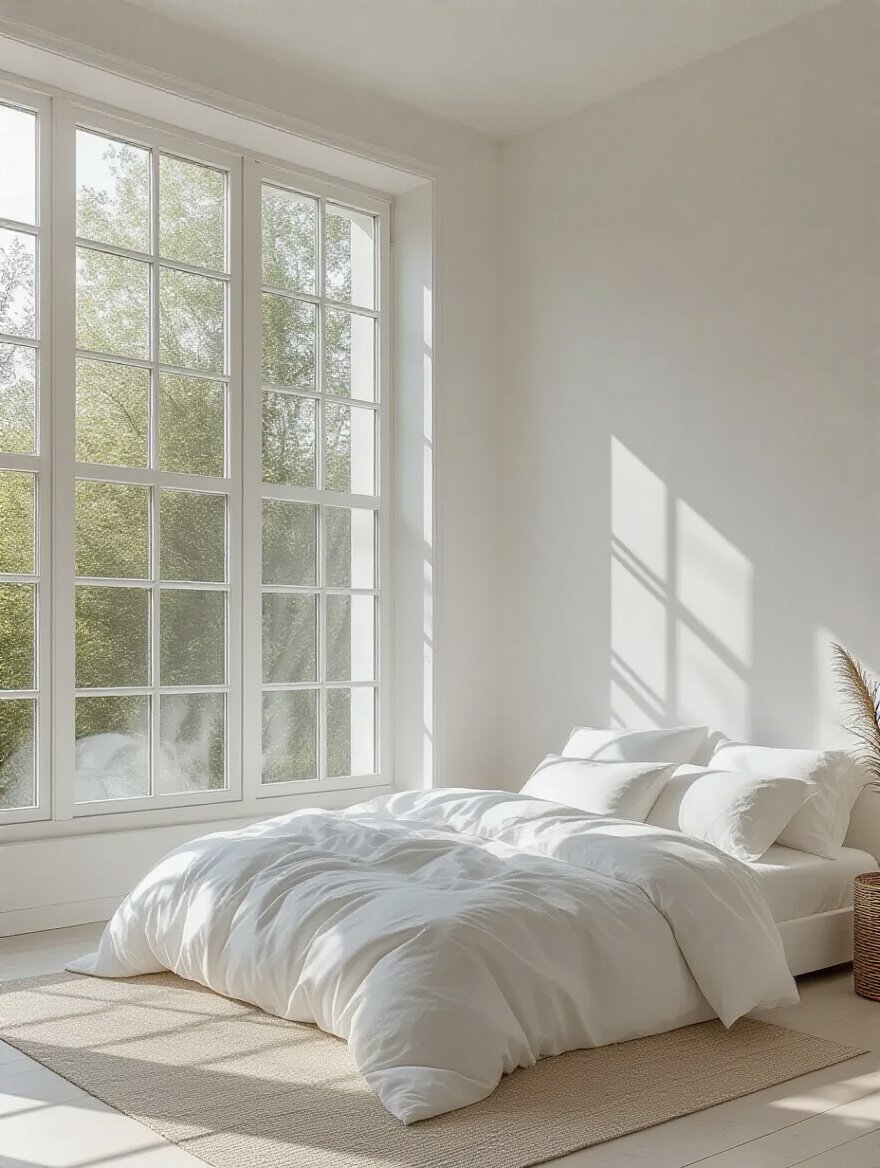
Save your subtle shine for the trim. Painting your baseboards, window frames, and doors in a satin or semi-gloss finish—in the exact same shade of white—creates a subtle, architectural contrast. You barely notice it consciously, but it adds a layer of tailored sophistication. It’s like the difference between a simple cotton tunic and one with a delicate, tone-on-tone embroidered border. One is lovely, the other is art. Don’t be afraid of textural finishes, either. A lime wash or a plaster-like finish can give your white walls a life and movement that flat paint never could, echoing the beautiful, hand-finished walls of a Mediterranean villa or a Rajasthani haveli.
Now for the best part—the place you’ll actually lay your head. The bed is the heart of the room, and it deserves to be dressed in layers of love.
7. Layer Luxurious White Bedding for Ultimate Comfort and Style
A single, flat white duvet on a bed is the saddest thing in the world. Your bed should be an irresistible, cloud-like invitation. This is where texture becomes your love language. The secret to a five-star hotel bed is layering, and in a white bedroom, it’s how you create an ocean of touchable luxury. Start with crisp, cool percale or soft, silky sateen sheets. Then, add a beautiful quilt or a light Indian dohar blanket for a middle layer.
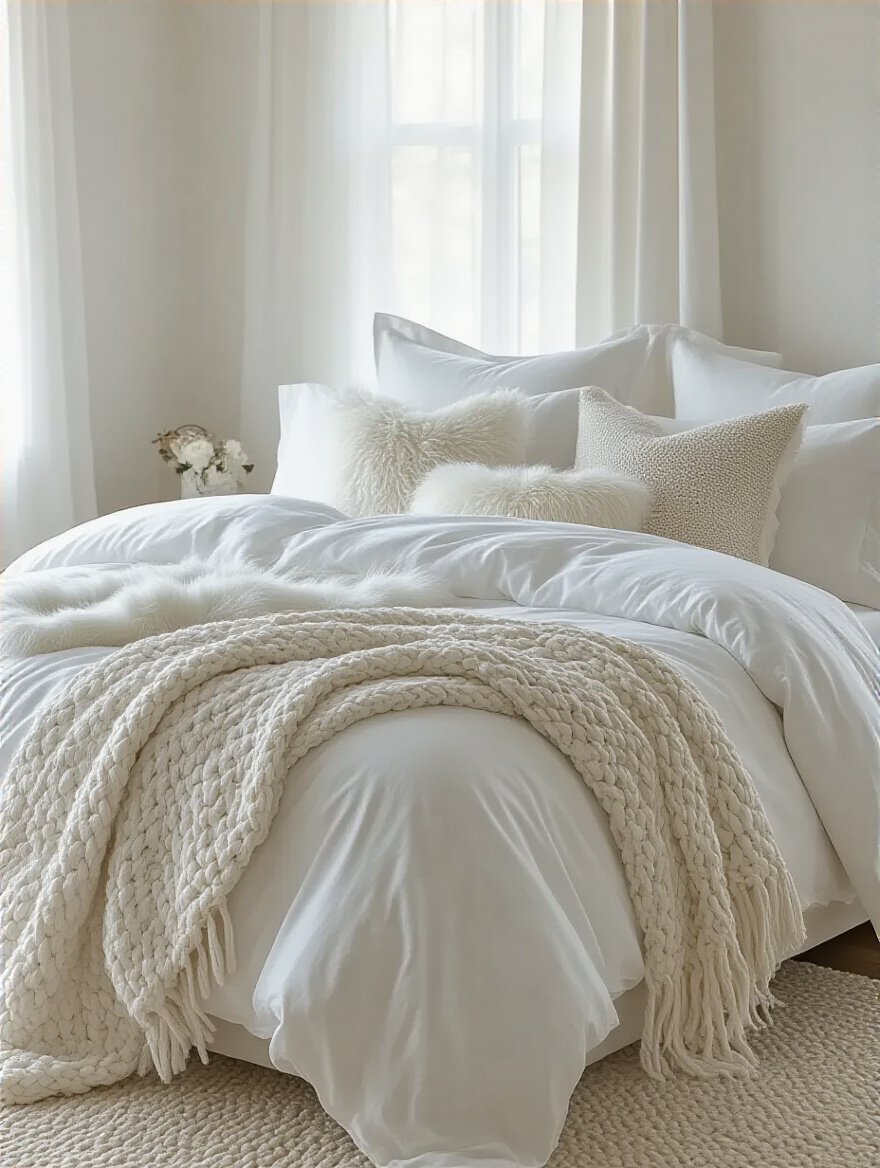
On top of that goes your duvet, but don’t just use a plain white cover. Find one with some personality! Look for the subtle, intricate white-on-white embroidery of chikankari from Lucknow, or a soft, crinkled linen that feels effortlessly chic. Finally, pile on the pillows and a throw. Mix a couple of fluffy euro shams, your sleeping pillows, and a long lumbar pillow. Mix textures: a waffle-knit cotton, a faux fur, a slubby linen. And at the foot of the bed, drape a chunky knit or a soft cashmere throw. Each layer has a different feel, a different sheen, and a different weight. It’s a feast for the senses, and it turns your bed from a piece of furniture into a destination.
Your feet need luxury, too. Let’s look down and create a foundation that feels as good as it looks.
8. Select Flooring Materials to Complement Your White Bedroom Aesthetic
The floor is the anchor for your entire room. The wrong choice can make your white sanctuary feel cold and ungrounded. You want something that complements the lightness but adds a touch of organic warmth. Light wood floors are a classic choice—think pale oak, ash, or maple. They reflect light and keep the space feeling airy while adding a natural, grounding element. A whitewashed or pickled finish can be stunning, creating a seamless transition from the walls.
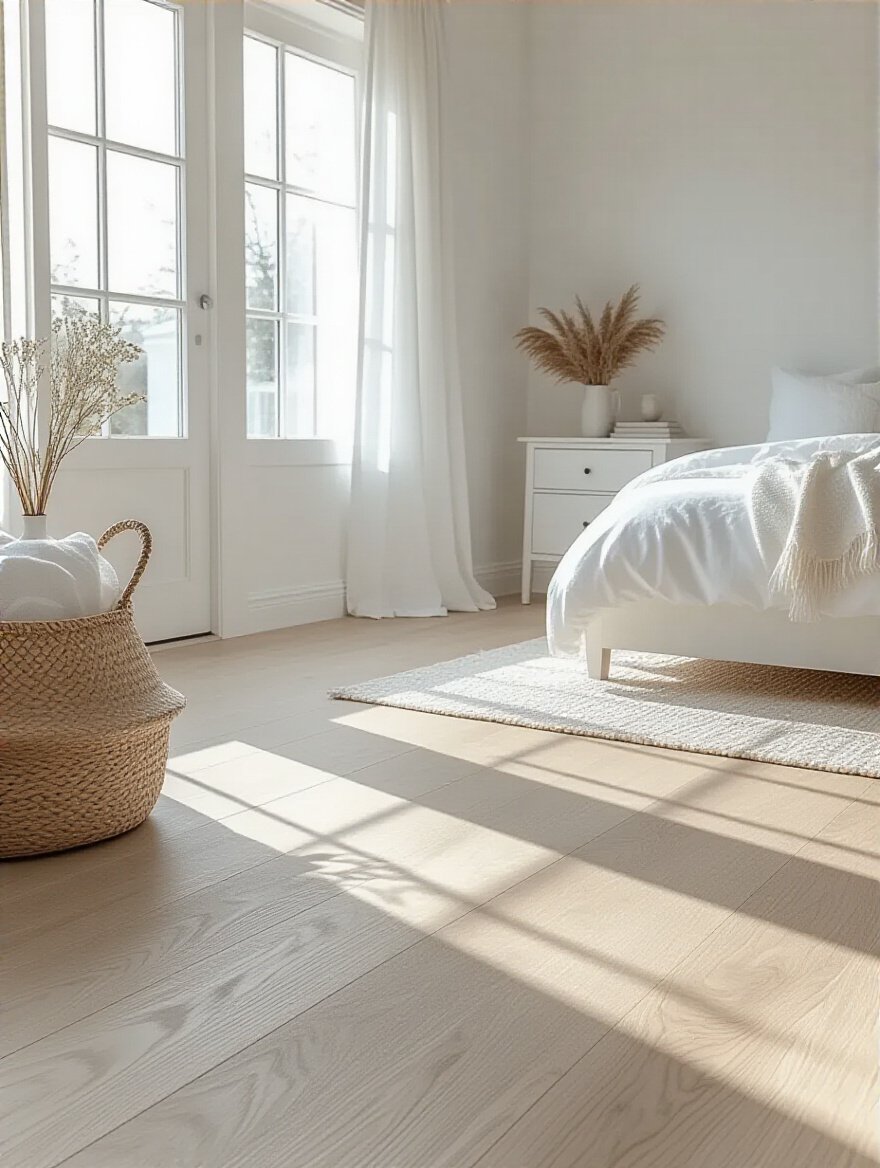
But don’t discount soft flooring! A wall-to-wall carpet in a creamy, off-white or a soft silver-grey can feel incredibly luxurious and helps absorb sound, making the room even more peaceful. The key is texture. A plush, high-pile carpet or a natural fiber rug like a soft jute or a wool Berber adds a layer of cozy, tactile warmth that bare floors can’t match. My personal weakness? A beautiful, hand-knotted wool rug in shades of ivory and cream placed over a light wood floor. It defines the sleeping area and gives you a story of true craftsmanship underfoot.
Now we light the stage. The right fixtures will make your white room glow from within.
9. Install Thoughtful Lighting Fixtures to Enhance White Ambiance
You can do everything else right, but if you have a single, harsh overhead light, you’ve failed. Lighting in a white bedroom isn’t about blasting the space with brightness; it’s about creating pools of warm, gentle glow. You need layers. Ambient light (your main, gentle overhead source), task light (for reading), and accent light (to add magic). And for the love of all that is holy, put everything on a dimmer. This is non-negotiable.

“In a white room, the light is your paintbrush. A dimmer switch is how you control the stroke.”
Think beyond a central fixture. Consider wall sconces on either side of the bed with soft fabric shades that cast a romantic glow. Place a beautiful lamp with a warm brass or wood base on your dresser. Maybe even a floor lamp in a corner to create a cozy reading nook. The goal is to make the light come from multiple places, at multiple heights. And the bulb temperature is key. You want a warm white (around 2700K). It’s that golden, candlelight glow that will make your white walls wrap around you like a warm embrace, not expose you in a clinical glare.
Adding Depth & Warmth: Texture and Organic Elements
This is the soul of the work. If the foundation is the bone, this is the flesh and blood. A white room without texture is a ghost. A white room filled with layers of nubby wools, soft linens, warm woods, and living things is a sanctuary that feels deeply and wonderfully alive.
10. Integrate Various Textures Through Throws, Rugs, and Pillows
We touched on this with the bedding, but let’s make it a mantra: Texture is the new color. In a white space, the interplay between rough and smooth, matte and shiny, soft and structured is what creates visual excitement. Think of it as a conversation. Your smooth cotton sheets whisper to the chunky knit throw, which argues playfully with a velvet pillow. Your soft, plush rug provides a silent, deep anchor for it all.
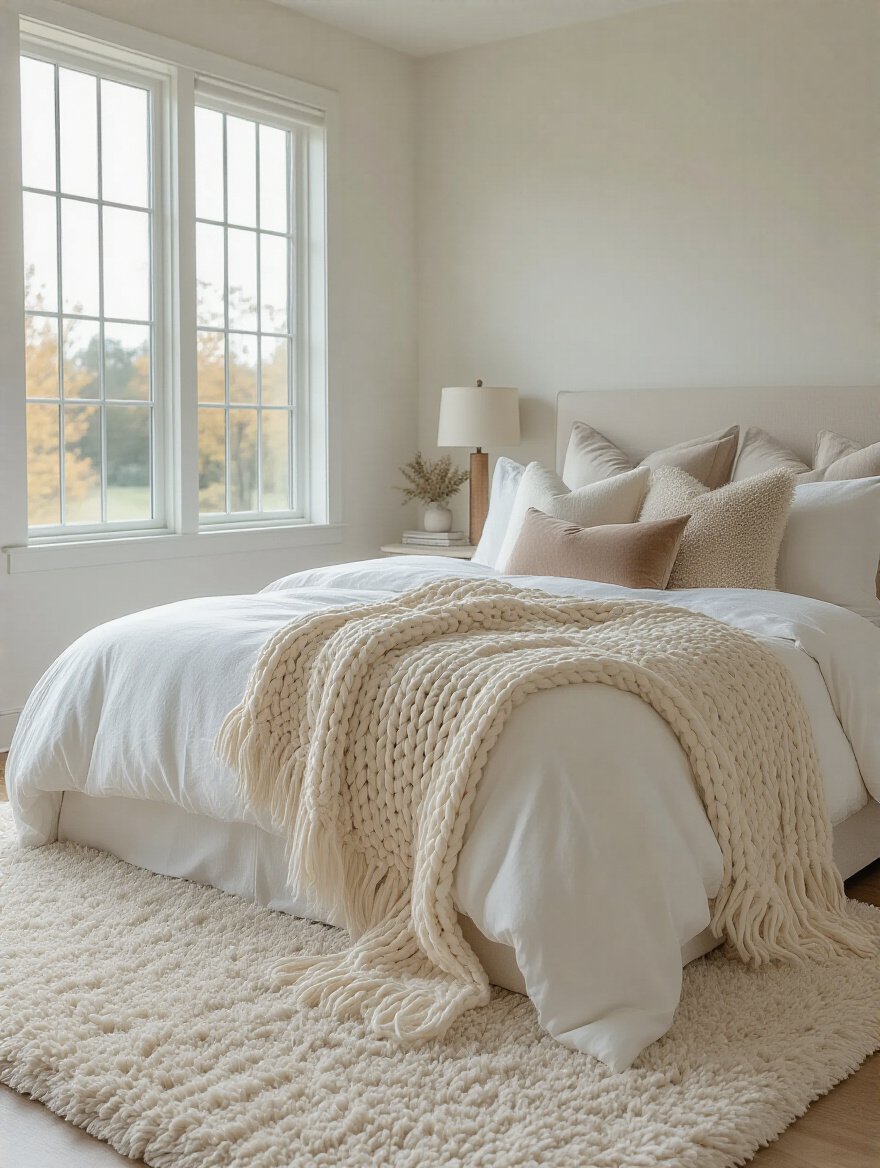
Don’t be shy. Drape a fluffy sheepskin throw over a chair. Use curtains made of heavy, raw linen that pool elegantly on the floor. Mix a variety of pillow covers—a simple cotton sham, a pillow with intricate embroidery, and maybe one made of soft bouclé. The goal is to create a space that begs to be touched. I once had a client who was scared of her white room feeling boring. We brought in a giant, hand-woven macrame wall hanging. It was all white, but its complex knots and long fringe gave the entire wall a dynamic, soulful energy that no paint color ever could.
These soft textures are beautiful, but they need something solid and organic to play against. Enter the unmatched warmth of wood.
11. Introduce Natural Wood Elements for Organic Warmth and Contrast
Wood is the ultimate antidote to sterile. It brings nature, warmth, and history into your white room. Just a few carefully chosen wood pieces can keep a white space from floating away, anchoring it to the earth. It could be a statement piece, like a carved headboard in a rich teak or mango wood, or smaller touches, like a live-edge wooden bench at the foot of the bed.
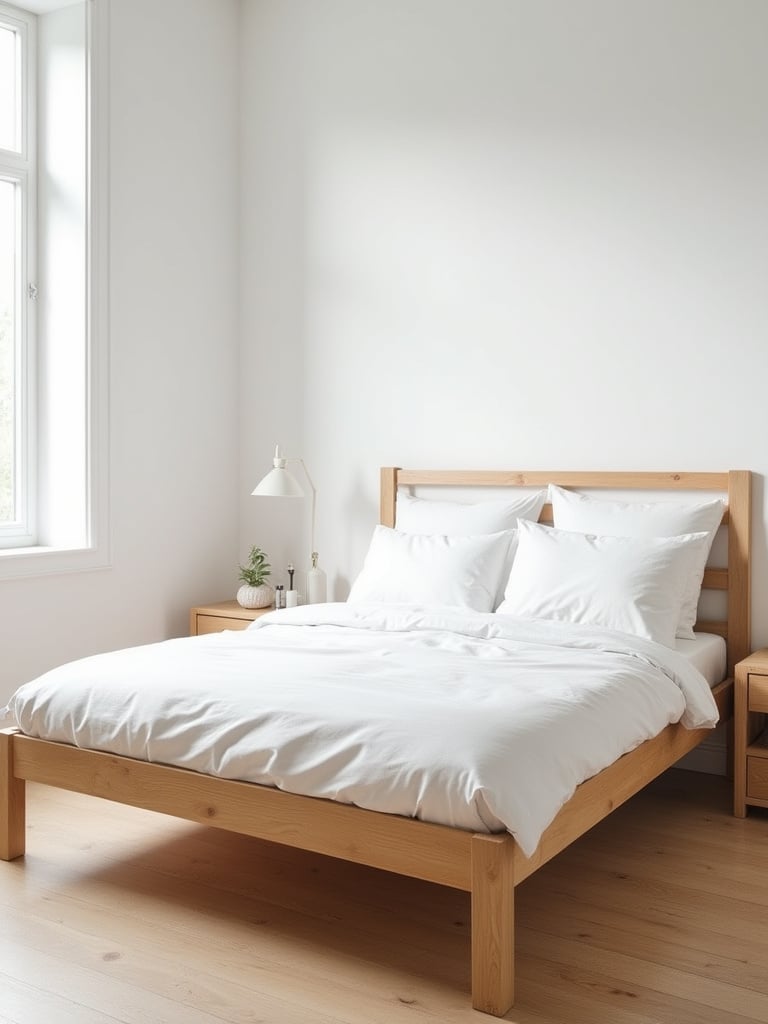
Even the smallest details matter. A set of wooden picture frames, a hand-carved decorative bowl on a dresser, or a simple wooden stool used as a plant stand can introduce that necessary touch of organic life. I love using antique pieces from India, like an old spice box or a small chapati table as a nightstand. They bring not just the warmth of the wood, but the warmth of a story. The grain, the knots, the imperfections of the wood tell a tale, adding a layer of soul that a brand new, mass-produced piece never could.
Now for a little bit of sparkle. The perfect jewelry for your room.
12. Employ Subtle Metallic Accents for Elegant Sparkle and Depth
Every room needs a little bit of jewelry, and in a white bedroom, metallics are what make the space sing. They catch the light, add a touch of sophisticated glamour, and keep the eye moving. The key word here is subtle. We’re not building a palace. My go-to is always warm metals like brass, bronze, or aged gold. Their warm, yellowy glow is the perfect complement to a white palette, making the room feel sunny and luxurious.
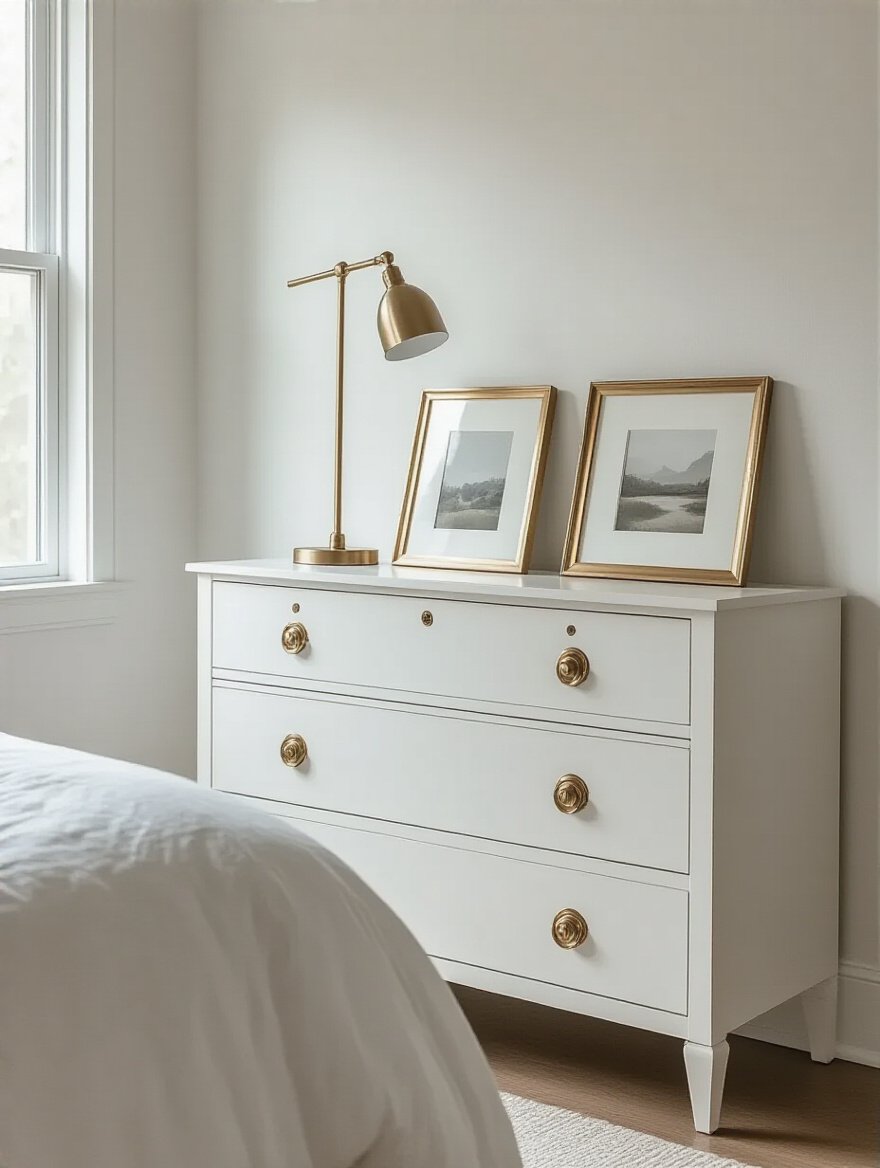
Think about swapping out the standard hardware on your dresser for beautiful brass pulls. Add a slender floor lamp with a bronze finish. Hang a mirror with a delicate, antique gold frame. It’s about small, thoughtful touches: a brass tray on the nightstand to hold your jewelry, a curtain rod with elegant brass finials. These little moments of shine break up the matte textures and add a layer of refinement. They’re the final, perfect accessory that pulls the whole outfit together.
The last piece of this puzzle is the most important: life itself.
13. Incorporating Greenery to Bring Life and Freshness to White Spaces
A white room without a plant is a room that isn’t breathing. Plants are living sculptures. They bring organic shape, vibrant life, and a pop of natural, perfect color that feels restorative, not distracting. The deep green of a fiddle-leaf fig against a crisp white wall is one of the most classic and beautiful pairings in design. They purify the air, yes, but more importantly, they purify the soul of the room.
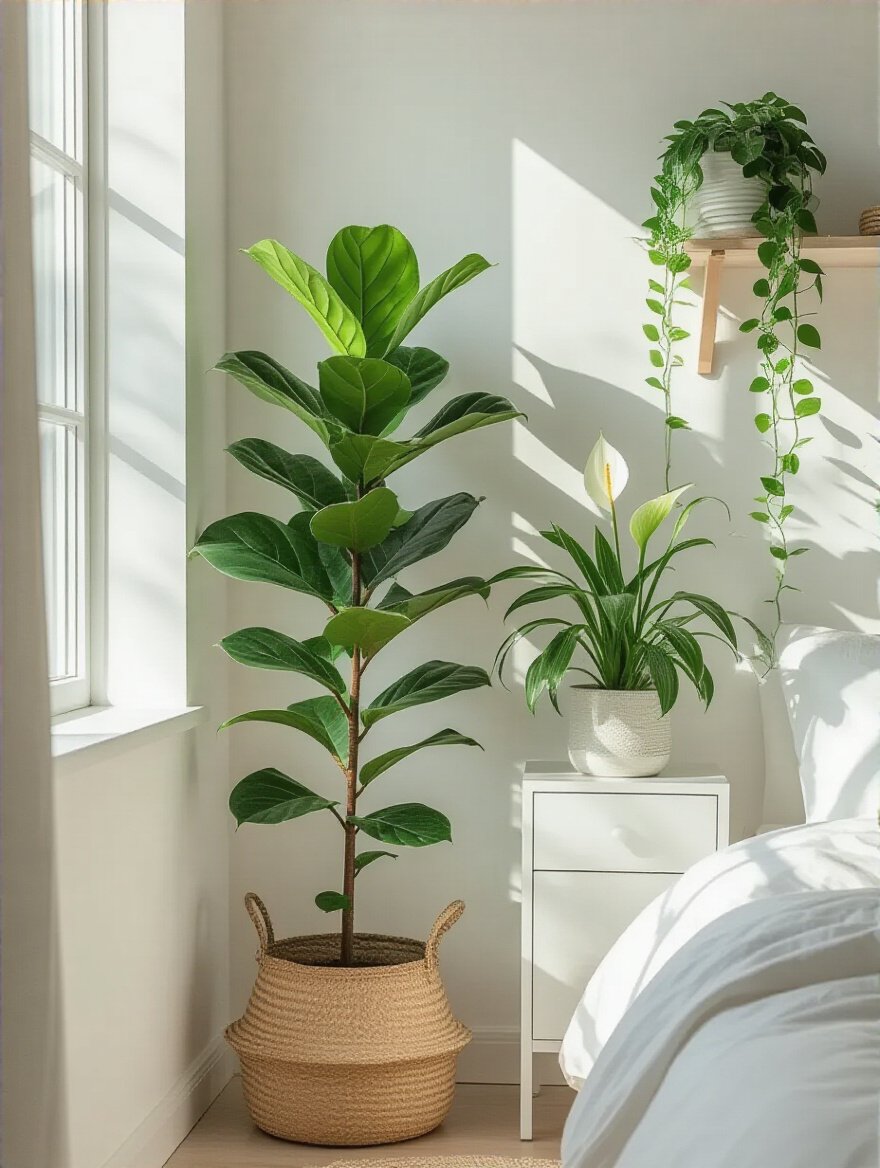
Vary the shapes and sizes. A tall, dramatic plant in a corner, like a snake plant or a monstera. A soft, trailing plant like a pothos or a string of pearls draping down from a high shelf. A small, delicate fern on your nightstand. And pay attention to the planters! A simple terracotta pot adds earthy warmth. A woven basket adds texture. A beautiful ceramic or brass planter adds an artisanal touch. Just a few well-placed plants can transform a static room into a vibrant, living, breathing ecosystem.
Personalizing Your Retreat: Accents and Finishing Touches
We’ve built a beautiful room. Now, we give it a soul. This is the final, most important layer—the one that makes the sanctuary unmistakably yours. These are the objects and art that hold your stories, your memories, and your dreams.
14. Curate Artwork That Adds Visual Interest Without Overwhelming Palate
Art in a white bedroom shouldn’t shout; it should whisper. You don’t need a blast of color to make a statement. Instead, look for art that has its own quiet power. A large-scale abstract painting with lots of white space and textural brushstrokes can be mesmerizing. A series of black-and-white photographs of a place you love tells a personal story without screaming for attention.
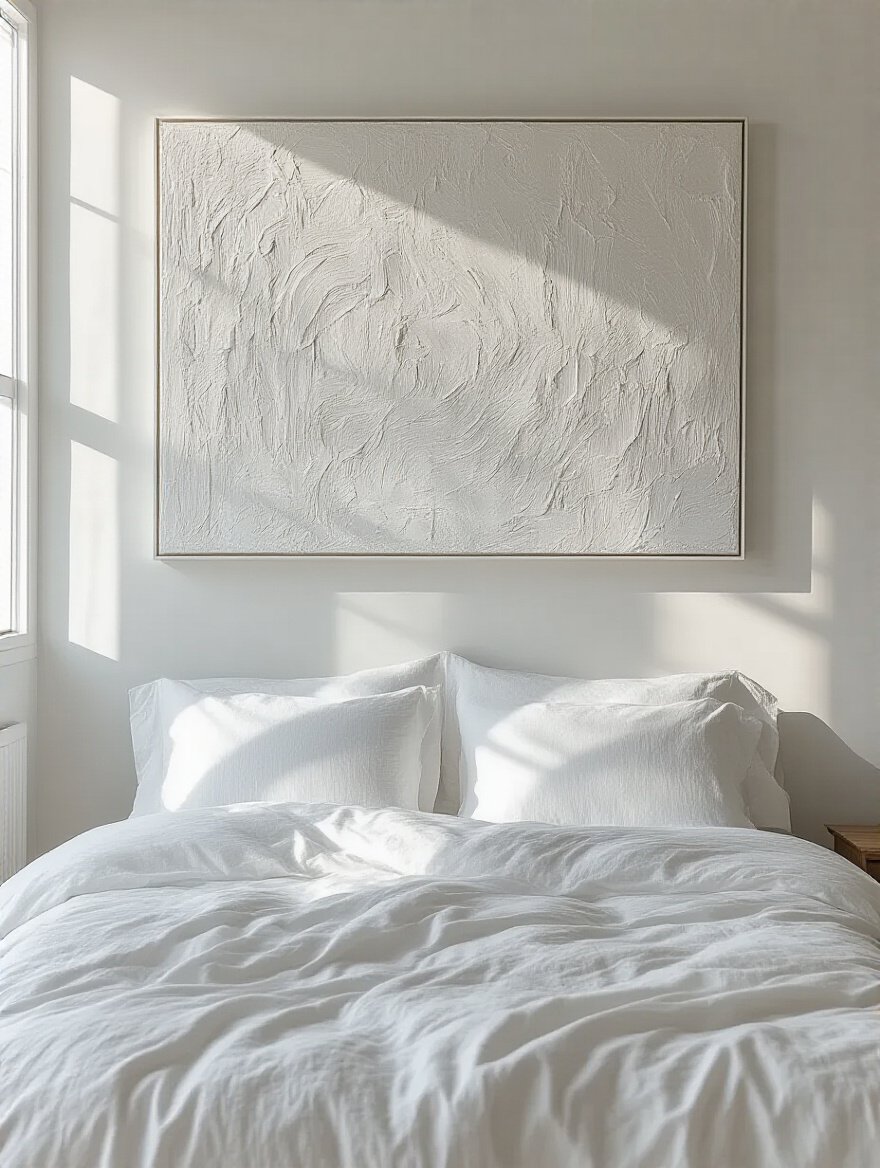
Think outside the canvas. A framed piece of antique textile, like a beautiful fragment of an old sari border or a piece of block-printed fabric, can be a stunning focal point. I love using delicate line drawings, like Indian Madhubani or Gond art, which have incredible detail and narrative within a simple palette. The key is to choose something that draws you in and makes you feel something, without visually hijacking the serene atmosphere you’ve worked so hard to create.
Now let’s look beyond the walls to the surfaces, and the stories they can hold.
15. Select Unique Decorative Objects to Infuse Personal Character
Your nightstand and dresser are not just for storage; they are stages for tiny, beautiful stories. This is where you display the treasures that make you, you. A stack of your favorite books. A small, hand-thrown ceramic bowl you bought on a trip. A beautiful piece of coral you found on a beach. A single, perfect candle in a scent you love. This is not about clutter; it is about curation.
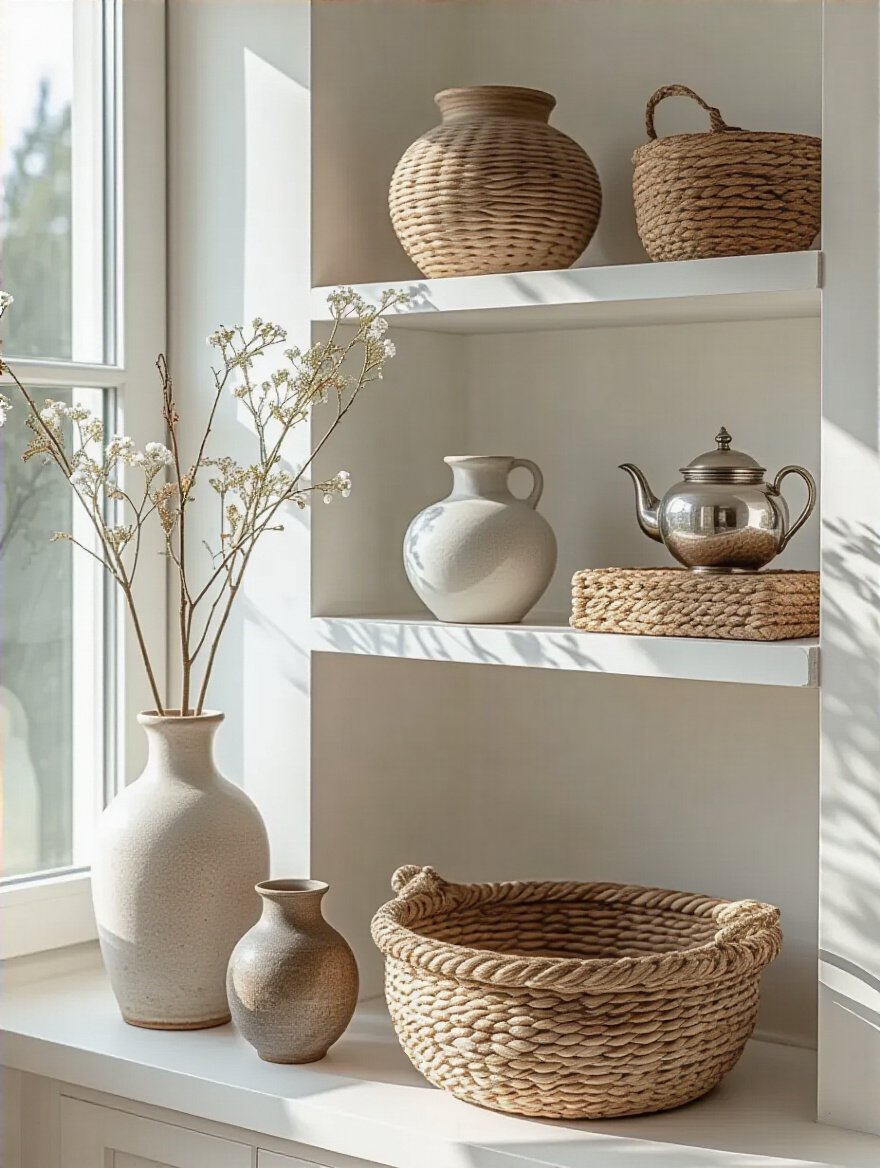
Follow the designer’s rule of three: group objects in odd numbers. A lamp, a small vase, and a framed photo. A stack of books, a small dish, and a beautiful stone. Grouping items on a tray—made of marble, wood, or brass—instantly makes them feel collected and intentional rather than scattered. These objects are your daily reminders of beauty, love, and adventure. They are the soul of the room made visible.
If you’re craving just a whisper of color, this is how you do it with grace.
16. Add Strategic Soft Color Accents Through Linens or Vases
Okay, if you absolutely must have color, here’s how to do it with sophistication. Think of it as a watercolor wash, not a thick slash of oil paint. Choose one or two soft, muted tones—a dusty rose, a pale sage green, a chambray blue, a warm terra cotta. Then, introduce them in small, strategic doses, primarily through textiles and small decor.
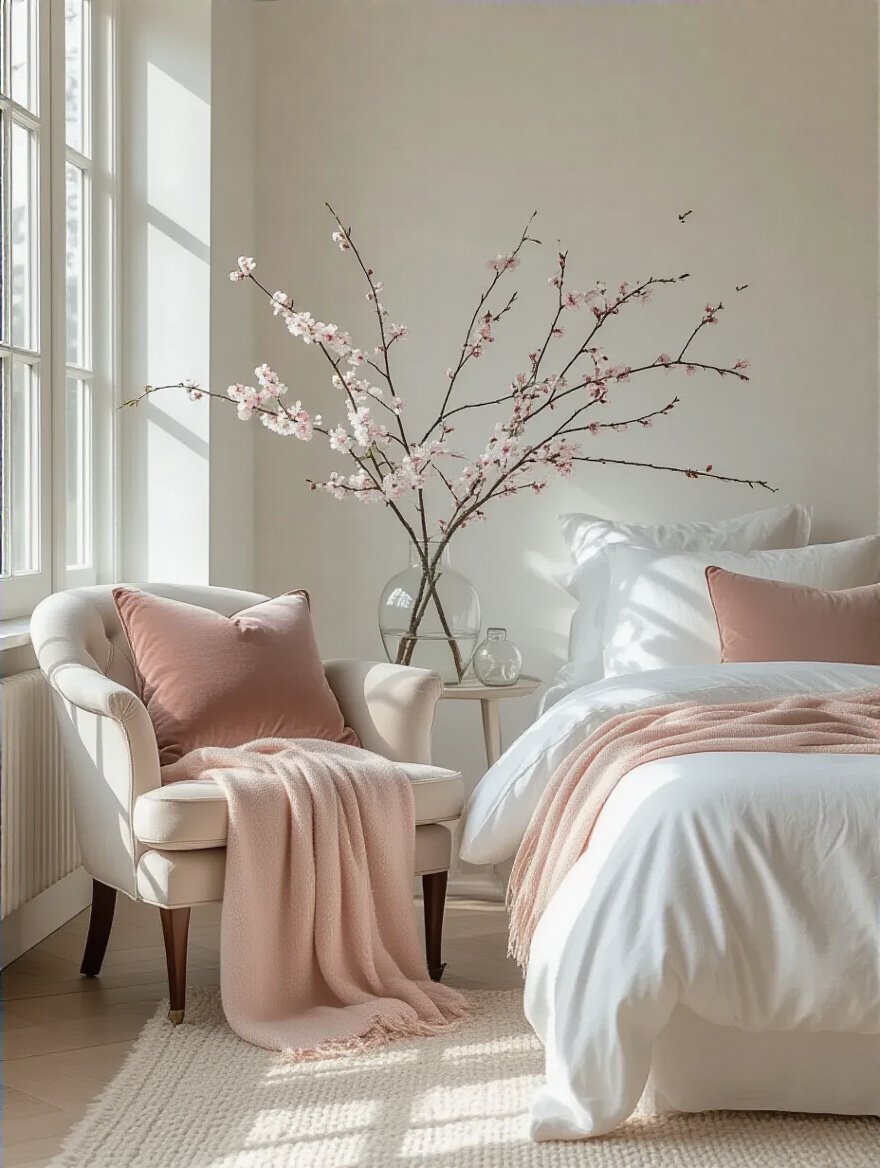
A single velvet throw pillow in a soft blush. A thin, gauzy linen throw in sage green at the foot of the bed. A set of towels in a muted blue. The other perfect place is in a vase. A beautiful ceramic vase in a soft, earthy tone can be a gorgeous accent, with or without flowers. The key is restraint. These pops of color should feel like a delightful surprise, a little grace note in an otherwise harmonious symphony of white.
To create the ultimate feeling of expansiveness, we’ll use a little bit of magic.
17. Utilize Large Mirrors to Expand the Perception of Space and Light
Mirrors are magic. They are the oldest trick in the design book for a reason. In a white bedroom, a large mirror is like adding another window. It grabs all that beautiful light you’ve cultivated and bounces it around the room, making the space feel bigger, brighter, and more alive. An oversized floor mirror leaning against a wall is effortlessly chic and can double the visual size of a room.
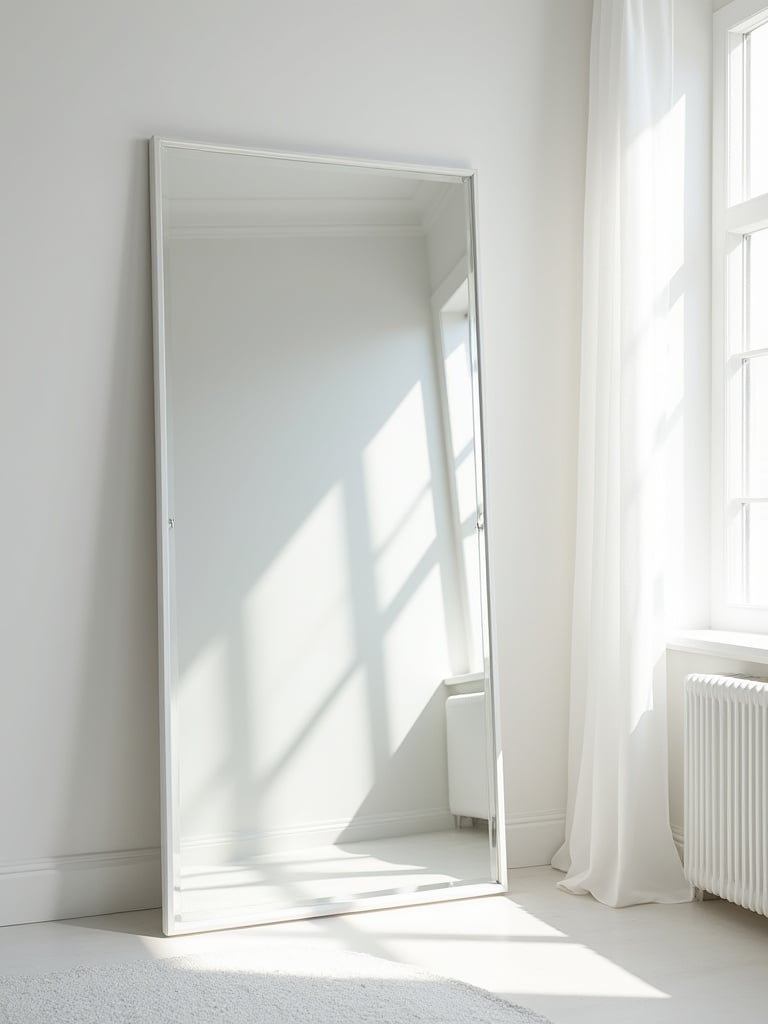
Placement is everything. Try to position your mirror so it reflects something beautiful—the light from a window, a lovely piece of art, or a view into another room. Don’t place it directly opposite your bed if you’re easily startled. But a mirror is more than just a functional object; it’s a design feature. Choose a frame with character—a beautiful carved wood, an elegant burnished metal, or even a bone-inlay frame from India to add another layer of artistry and story.
And finally, the last touch, the one that ties it all together.
18. Display Meaningful Personal Keepsakes for a Soulful, Lived-In Feel
This goes beyond just decorative objects. These are the items with true heart. Your grandmother’s reading glasses. Your child’s first clay creation. A pressed flower from a meaningful bouquet. These items are probably not “designer,” and they don’t have to be. Their value is emotional, and that is what will make your room a true sanctuary.
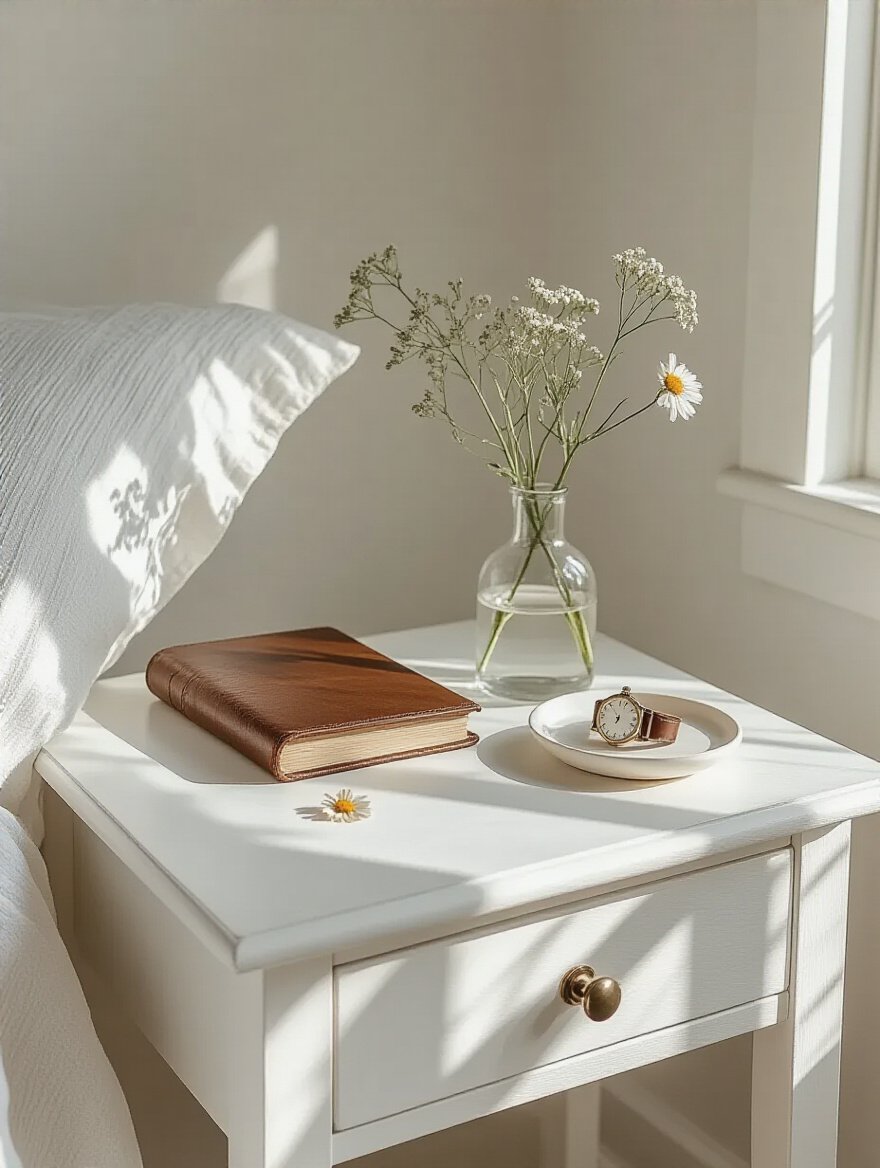
Find a place of honor for them. A small shadow box for delicate items. A special spot on your bedside table. These are the things that will make you smile when you wake up in the morning and feel a sense of peace when you turn out the light at night. A room can be perfectly decorated, but without these little pieces of your life, it will always lack a soul. This is the final, essential ingredient that turns a house into a home.
Embrace the Serene Glow: Your White Bedroom Sanctuary Awaits
So you see? A white bedroom is a deeply personal journey. It’s a mindful layering of light, texture, and love. It’s a commitment to creating a space that doesn’t just look serene but actually feels serene—a space that calms your nervous system and welcomes you home to yourself. It’s a canvas that will grow and evolve with you, always ready to hold your stories.
Don’t be afraid of the quiet. Embrace the subtle dance of whites and ivories, the conversation between soft wool and warm wood, the gentle glow of a brass lamp. You have the secrets now. You know that the soul is in the details, the warmth is in the texture, and the peace is in the purpose. Go create the sanctuary you deserve.
